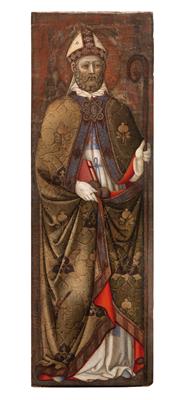Sienese follower of Gentile da Fabriano

(second quarter of the 15th Century)
Saint Nicholas of Bari,
tempera on silver ground panel, 126 x 39.5 cm, unframed
Provenance:
art market, France;
where acquired by the present owner
The present panel relates to the presence of Gentile da Fabriano in Siena in 1425, during the time when he left a vivid impression on the local school of painters. The strong influence of Gentile is evident in this painting in the elegant pictorial description of the decorative elements of the composition: in the emphasis on the material refinement of the bishop’s damask mantle with gilded edges, set against a silver ground, and in the technique – notably peculiar to Gentile and his followers – of the delicate ‘a puntinato’ rendering, deployed to depict the shoes and white under-robe with red and blue embroidery worn by the saint.
The subject’s features however are typically Sienese and reflect the style of Sassetta and the so-called Maestro dell’Osservanza, as does the softly modulated handling of light and shade and the gothicising drapery. It has been suggested that in this work it is possible to discern the early phase, closely allied to Gentile, of the rare Sienese painter known as the Master of Saint Ansano tentatively identified as Pietro di Ruffolo. Indeed, the present painting can be compared to five panels attributed to this master by Miklós Boskovits: the Saint Nicholas of Bari, Saint John the Baptist, the Madonna, Saint John the Evangelist and the Saint Jerome from the Kress Collection now in the Columbia Museum of Art, South Carolina (inv. no. CMA 1952.24; see M. Boskovits, Il Gotico rivisitato: proposte e commenti su una mostra, in: Arte Cristiana, LXXI, 1983, pp. 269, 275 nota 51).
An outline of the Master of Saint Ansano’s artistic production was first advanced by Boskovits when he proposed uniting a small group of works in relation to a series of three miniatures in the Graduale 98.4 of the Museo dell’Opera del Duomo di Siena, (op. cit. Boskovits 1983, pp. 259-276), as well as a section of the monochrome frescoes in the portico and cloister of the hermitage of Lecceto near Siena.
This mysterious master derives his moniker from two frescoes in the Oratorio di Sant’Ansano in Castelvecchio, Siena, representing the Adoration of the Magi and Saint Ansanus. In all likelihood the artist was active from 1430 through the 1450s: starting from late Gothic models, his manner adopted and incorporated the currents of Sienese fifteenth century painting, in step with artists such as Sassetta, Domenico di Bartolo and Vecchietta, to achieve a refined and personal stylistic fusion of the Sienese Gothic inheritance and the new pictorial stylistic tendencies of the Quattrocento.
Specialist: Mark MacDonnell
 Mark MacDonnell
Mark MacDonnell
+43 1 515 60 403
mark.macdonnell@dorotheum.at
08.06.2021 - 16:00
- Estimate:
-
EUR 70,000.- to EUR 90,000.-
Sienese follower of Gentile da Fabriano
(second quarter of the 15th Century)
Saint Nicholas of Bari,
tempera on silver ground panel, 126 x 39.5 cm, unframed
Provenance:
art market, France;
where acquired by the present owner
The present panel relates to the presence of Gentile da Fabriano in Siena in 1425, during the time when he left a vivid impression on the local school of painters. The strong influence of Gentile is evident in this painting in the elegant pictorial description of the decorative elements of the composition: in the emphasis on the material refinement of the bishop’s damask mantle with gilded edges, set against a silver ground, and in the technique – notably peculiar to Gentile and his followers – of the delicate ‘a puntinato’ rendering, deployed to depict the shoes and white under-robe with red and blue embroidery worn by the saint.
The subject’s features however are typically Sienese and reflect the style of Sassetta and the so-called Maestro dell’Osservanza, as does the softly modulated handling of light and shade and the gothicising drapery. It has been suggested that in this work it is possible to discern the early phase, closely allied to Gentile, of the rare Sienese painter known as the Master of Saint Ansano tentatively identified as Pietro di Ruffolo. Indeed, the present painting can be compared to five panels attributed to this master by Miklós Boskovits: the Saint Nicholas of Bari, Saint John the Baptist, the Madonna, Saint John the Evangelist and the Saint Jerome from the Kress Collection now in the Columbia Museum of Art, South Carolina (inv. no. CMA 1952.24; see M. Boskovits, Il Gotico rivisitato: proposte e commenti su una mostra, in: Arte Cristiana, LXXI, 1983, pp. 269, 275 nota 51).
An outline of the Master of Saint Ansano’s artistic production was first advanced by Boskovits when he proposed uniting a small group of works in relation to a series of three miniatures in the Graduale 98.4 of the Museo dell’Opera del Duomo di Siena, (op. cit. Boskovits 1983, pp. 259-276), as well as a section of the monochrome frescoes in the portico and cloister of the hermitage of Lecceto near Siena.
This mysterious master derives his moniker from two frescoes in the Oratorio di Sant’Ansano in Castelvecchio, Siena, representing the Adoration of the Magi and Saint Ansanus. In all likelihood the artist was active from 1430 through the 1450s: starting from late Gothic models, his manner adopted and incorporated the currents of Sienese fifteenth century painting, in step with artists such as Sassetta, Domenico di Bartolo and Vecchietta, to achieve a refined and personal stylistic fusion of the Sienese Gothic inheritance and the new pictorial stylistic tendencies of the Quattrocento.
Specialist: Mark MacDonnell
 Mark MacDonnell
Mark MacDonnell
+43 1 515 60 403
mark.macdonnell@dorotheum.at
|
Buyers hotline
Mon.-Fri.: 10.00am - 5.00pm
old.masters@dorotheum.at +43 1 515 60 403 |
| Auction: | Old Master Paintings I |
| Auction type: | Saleroom auction with Live Bidding |
| Date: | 08.06.2021 - 16:00 |
| Location: | Vienna | Palais Dorotheum |
| Exhibition: | 29.05. - 08.06.2021 |
